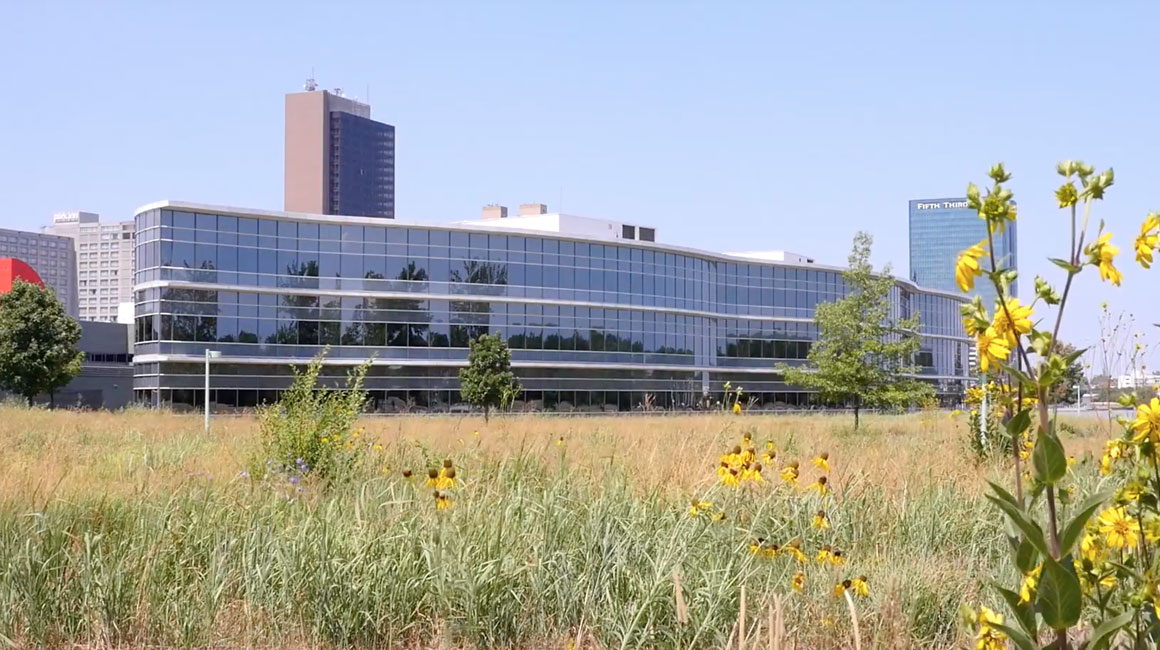Property & Facility Management & Engineering
Property & Facility Management & Engineering
| 210.8M | square feet under management |
| 477 | number of property managers |
| 1,130 | number of engineering employees |
Hines will implement the energy intelligent software to support real-time energy monitoring, as well as an environmental management system. The firm will also test battery storage technology to manage energy use and cost.
Partnered with EnerNOC and began to rollout an energy intelligent platform and environmental management system across our portfolio. The firm also explored battery storage technology in several markets, and identified several opportunities.
Hines will increase the number of properties on the energy and environmental management platform. The firm will also commit to at least one battery storage installation, pilot the new ENERGY STAR platform for tenant spaces, and explore opportunities to expand the Hines GREEN OFFICE® program.

- Introduction
- Adapting Spaces and Services to Empower Tenants
- 2017 Tenant Satisfaction Survey
- Managing at the Property Level
- COES Standards
- Tracking Building Performance
- Hines and ENERGY STAR
- Water Tracking and Initiatives
- Waste Diversion
- Greenhouse Gas (GHG) Emissions
- Paper-Lite Program
- Hines GREEN OFFICE Program
- Hines Best Practices
- Hines Procurement
- Contractor and Vendor Policies
- Tenant Manuals
- 33 Tehama Celebrates Public Art
- Owens Corning Wildlife Habitat Council Certification
Ensuring that operations and engineering runs efficiently and productively remain core to Hines’ facilities management teams. However, facilities management is transforming from a building and engineering-centered activity to one which focuses on the user experience, technology enablement and measurable outcomes. Hines’ facilities management creates an environment that embraces the convergence of technology, wellness and facilities services that enhances corporate performance for our clients.
From financial services firms to materials manufacturers, from technology enterprises to energy companies—Hines has provided facilities management to third-party clients for more than 24 years. As a vertically integrated firm, Hines’ facilities management combines best-in-class engineering, a holistic approach to property management, global vendor relationships and superior development expertise. This results in optimal building performance, occupant satisfaction and well-being, and asset value. Hines’ role as an investor and developer also supports our approach to facilities management from an owner’s perspective to deliver unparalleled service.
Hines facilities managers and engineers provide a high level of operations expertise, and a willingness to innovate and change. Attention to operational detail remains a core tenet. To ensure our clients’ satisfaction, we are adapting to the rapid transition in facilities management. This includes creating wellness programs and events, constructing and maintaining flexible and collaborative workspaces, providing nutritious food and beverage options, designing biophilic spaces and exploring renewable energy options.
A new generation of workers and technology is driving a transformation in commercial real estate and Hines’ facilities managers are responding with strategic thinking, an eye for continuous improvement and innovation, and empathy for the clients they support.
Hines commissions a third party, Kingsley Associates, to conduct surveys across the firm’s U.S. office portfolio to gauge tenant satisfaction. The 2017 survey, administered as a web survey by email invitation, had 1,913 respondents—a 91 percent response rate. When asked to rate overall satisfaction with Hines, 95 percent of tenants rated their satisfaction as “good” or “excellent”—a three percent increase from the 2015 survey. Ninety-seven percent of tenants rated their satisfaction with Hines property management as “good” or “excellent,” which exceeded the Kingsley Index by six percent. Furthermore, tenant satisfaction with Hines’ commitment to sustainability increased two percent since the 2015 survey to 84 percent.
Reason for Interest in Sustainable Initiatives
| 69% | healthier work environment |
| 57% | cost savings |
| 50% | corporate responsibility goals |
| 30% | attracting and retaining employees |
| 26% | engaging with customers and the community |
A multitude of factors contribute to building performance: local climate, regulatory context, building history and tenant requirements. Accordingly, Hines property managers and engineers are charged with the greatest responsibility at the property level. Property managers are responsible for the daily operation of the property including tenant relations, lease administration, on-site accounting, security, cleaning and other contract services. Engineers are responsible for management and maintenance of all building systems and infrastructure.
Properties are supported by the Hines Corporate Operations & Engineering Services department and the Operations Management Committee.
Corporate Operations & Engineering Services (COES)
COES supports Hines’ on-site management teams by providing standards guidelines and periodic assessments of property administration; risk administration; personnel management; contract services; mechanical physical facilities; preventive maintenance; energy management; equipment efficiency; water treatment; and personnel development.
Operations and engineering assessments are performed every two to five years based on a property-specific risk matrix. An assessment report is provided by the review team following the assessment, which includes an executive summary, a listing of all areas reviewed, any findings and suggested remedies. Each item reviewed either “Meets,” “Meets with Few Exceptions” or “Does Not Meet” the Hines standards for either operations or engineering. Specific action plans are developed for areas that do not meet expectations.
Operations Management Committee (OMC)
The OMC serves as an interface between property-level management and executive leadership, providing problem-solving and guidance on issues, standards and best practices that can benefit multiple properties or regions.
COES has developed and updates core standards that detail processes and the expectations of property management and engineering teams at all U.S. properties. These are also provided as a resource for international properties, where local technologies and resources require adaptation of the U.S. standards.
Utility Cost Reduction Programs
The Hines portfolio contains older buildings, recently acquired buildings and new buildings. This standard ensures that new technologies, programs and cost-effective, energy-saving retrofits are actively being evaluated, presented to management and ownership for approval, and implemented.
Chiller Performance Test
Chillers are estimated to account for up to 20 percent of total electrical consumption. This standard defines procedures for chiller performance testing at regular intervals with quality field instrumentation; setting of rating targets; and organized, accurate record keeping.
Refrigerant Management Program (RMP)
Implementation of the RMP helps ensure that the requirements of Section 608 of the Environmental Protection Agency’s 1990 Clean Air Act are met. In meeting these requirements, Hines complies with federal law, limits refrigerant losses, conscientiously manages refrigerant supplies, reduces costs, and minimizes risk to the environment, personnel and the company.
Indoor Air Quality (IAQ)
Buildings require proactive management to prevent health concerns. Hines has developed comprehensive guidelines, in conjunction with industry standards, for the prevention, investigation and correction of IAQ issues, including thermal comfort, ventilation and airborne irritants such as bioaerosols, vapors and toxins. Key to implementation is the appointment of an IAQ manager for each property.
Energy Control and Optimization System (ECOS) Standard
This standard guides effective use of the ECOS application during setup; monthly and annual updates, including documentation of significant year-over-year variances; energy improvement measures; and operational changes.
Hines engineers track energy consumption at Hines-managed properties. Energy management and conservation practices occur daily as engineers balance equipment to demand loads based on weather, time of day and tenant activity. Utility meter tracking and reporting serves as a benchmarking tool for month-to-month, year-to-year and property-to-property comparisons. Hines does not set blanket reduction mandates; optimum efficiency is continually achieved by rigorous assessment and identification of strategic infrastructure improvements.
Using a proprietary web-based application called ECOS, engineers input property information, certifications, monthly utilities cost and consumption totals, degree days and average occupancy.
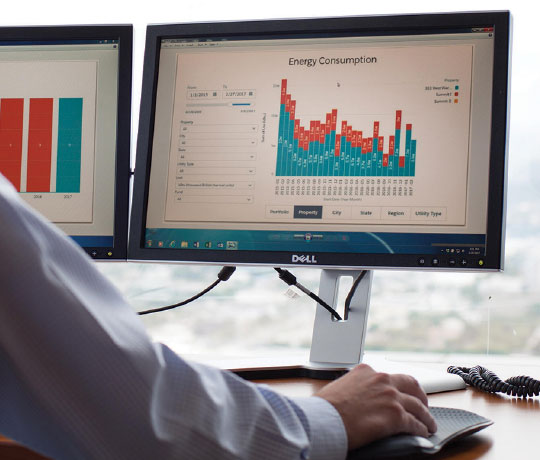
Building Energy Intensity by Region 2011–20176
Energy intensity for properties that represent predominately office space as determined from total building energy data vs. average benchmark usage
The U.S. Environmental Protection Agency’s ENERGY STAR program includes an energy performance rating system for commercial buildings. In 1999, Hines became the first international and privately held real estate company in the world to commit to ENERGY STAR. Since then, Hines has earned labels for 1,696 buildings. Hines’ specific ENERGY STAR strategy and initiatives are led by the ENERGY STAR Management Group (ESMG). This team, formed in 2001, consists of engineering leaders from Hines’ central headquarters and every U.S. Hines business region that has developed special networks with their engineering colleagues to support firm-wide energy conservation goals.
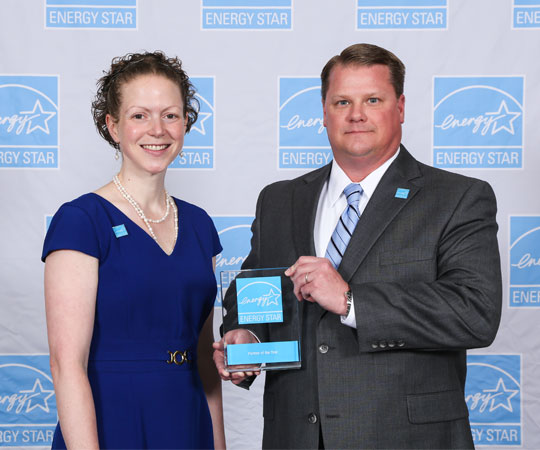
Chad Engle, Vice President of Corporate Engineering, accepts the ENERGY STAR 2017 Partner of the Year award on behalf of Hines, marking 10 years of Sustained Excellence.
Comparison of Hines ENERGY STAR-labeled Buildings to the National Median7
| 30.0% | more energy efficient |
| $1.47 | energy cost savings per sf per year |
| $45.2M | total portfolio savings per year |
| 240,009 | metric tons annual reduction in CO2e |
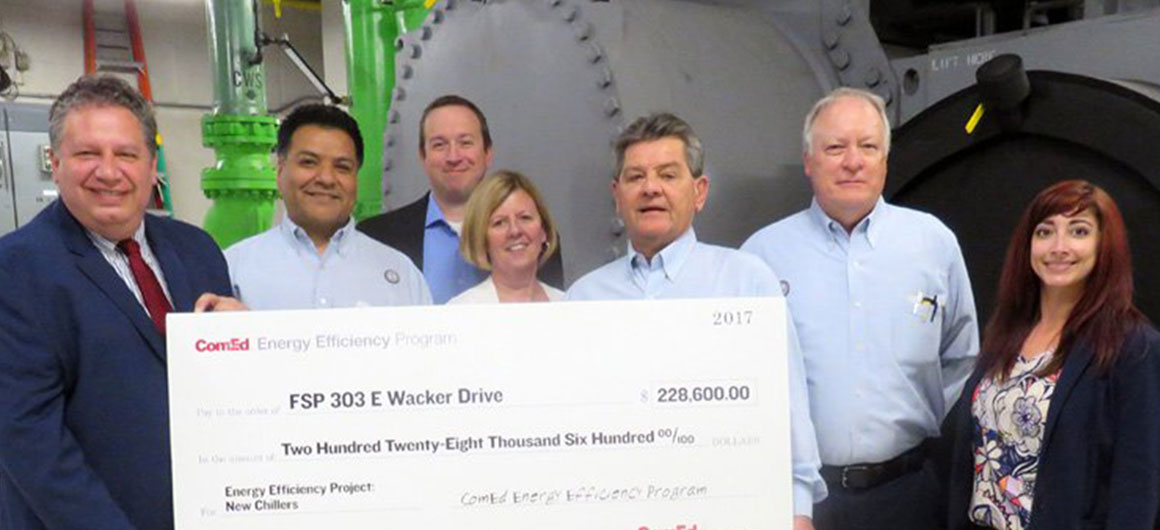
Turning Efficiency into Value at 303 East Wacker, Chicago The property management staff at Chicago’s 303 East Wacker received a sizeable rebate check from energy provider ComEd. The rebate was awarded following the property’s recent chiller replacement project, which included the installation of two chillers, variable speed drives and LED lighting upgrades. All told, the renovations contributed to a power savings of over 1.4 million kilowatt hours.
Water consumption and costs, derived from utility bills, are tracked in ECOS by building engineers. Despite years where water consumption increases due to factors such as increased occupancy, Hines has leveraged green building standards that have decreased water consumption over the long-term. Hines continues to evaluate the lifecycle water savings and costs of restroom retrofits in existing buildings.
U.S. Building Water Intensity 2013–20178
Historical water intensity for properties that represent predominately office space as determined from total building water data
In 2013, Hines added tracking of waste and recycling to ECOS. Unique solutions were integrated to accommodate regional differences in waste management, such as incineration for fuel use in Europe. Hines Central Resources provided web-based training and tools to all properties.
Solid Waste Diversion 2012–20179
The solid waste diversion rate is the amount of recycled waste as a percent of the total solid waste for properties across our regions. The goal is to increase the amount of waste diverted from landfills and so raise the percentage diversion rate.
Hines recognizes that as a property owner and manager in over 100 cities worldwide, it can contribute to the carbon reduction goals of municipalities and tenants.
Directly, Hines focuses on the energy-efficient operation of its buildings. By rigorously tracking energy consumption and refrigerants, Hines can account for GHG emissions. At present, Hines does not find that the conversion of energy consumption into carbon equivalents adds meaning to help the company manage buildings more effectively. Most Hines properties do not currently utilize electricity from renewable sources, except where provided in the standard grid power mix from local utilities.
Indirectly, adherence to the LEED, ENERGY STAR and other international sustainability certificates inherently reduces the carbon impact of new developments and building lifecycles. Additionally, the HinesGO® (GREEN OFFICE®) for Tenants program provides practical GHG reduction-yielding tools for tenants.
Refrigerants
Unavoidable leakage of refrigerant GHG emissions from cooling systems is tracked and reported monthly by building engineers at all U.S. properties. By testing and maintaining systems in peak condition, engineers work to avoid these emissions to the greatest extent possible in existing buildings.
The Global Document Center (GDC) created the Paper-Lite Program to reduce storage of paper documents by transferring them to digital data. By using the program, Hines offices reduce the costs of on-site and off-site storage space, supplies and manpower; lower audit risks and facilitate compliance and discovery; enhance data access, retrieval and knowledge sharing across the enterprise; and eliminate redundancy and increase efficiency. The program is governed by the Hines Document and Record Retention Policy and the Global Retention Schedule.
Once all the documents have been scanned and uploaded, the originals are archived at Iron Mountain and the paper copies are secure shredded.
2017 Statistics
| 96,836 | pounds of paper recycled |
| 821 | trees saved |
| 1,327,186 | gallons of water saved |
| 109,425 | kWh electricity reduction |
| 242 | cubic yards of landfill reduction |
2006–2017 Secure Shredding — Environmental Benefits
| 322,412 | pounds of paper recycled |
| 2,714 | trees saved |
| 4,418,818 | gallons of water saved |
| 364,326 | kWh electricity reduction |
| 806 | cubic yards of landfill reduction |

In 2008, Hines initiated HinesGO® (Hines GREEN OFFICE®) to measure and reward sustainable practices within Hines offices worldwide, and a year later Hines launched the program for voluntary participation by tenants. Leaf Credits are earned by implementing specific strategies or improvements in six categories: energy efficiency; people and atmosphere; reduce, reuse, recycle; LEED; travel and commuting; and remodeling and construction.
| 653 | active tenants have achieved GREEN OFFICE® ratings |
| 28.8 | million leased square feet of GREEN OFFICE® tenants |
| 36.7% | of total occupied space firm-wide in the program |
HinesGO® Scorecard
Leaf Credits are earned by implementing specific strategies or improvements in six categories.
A minimum of 70 Leaf Credits qualifies an office for the GREEN OFFICE® designation.
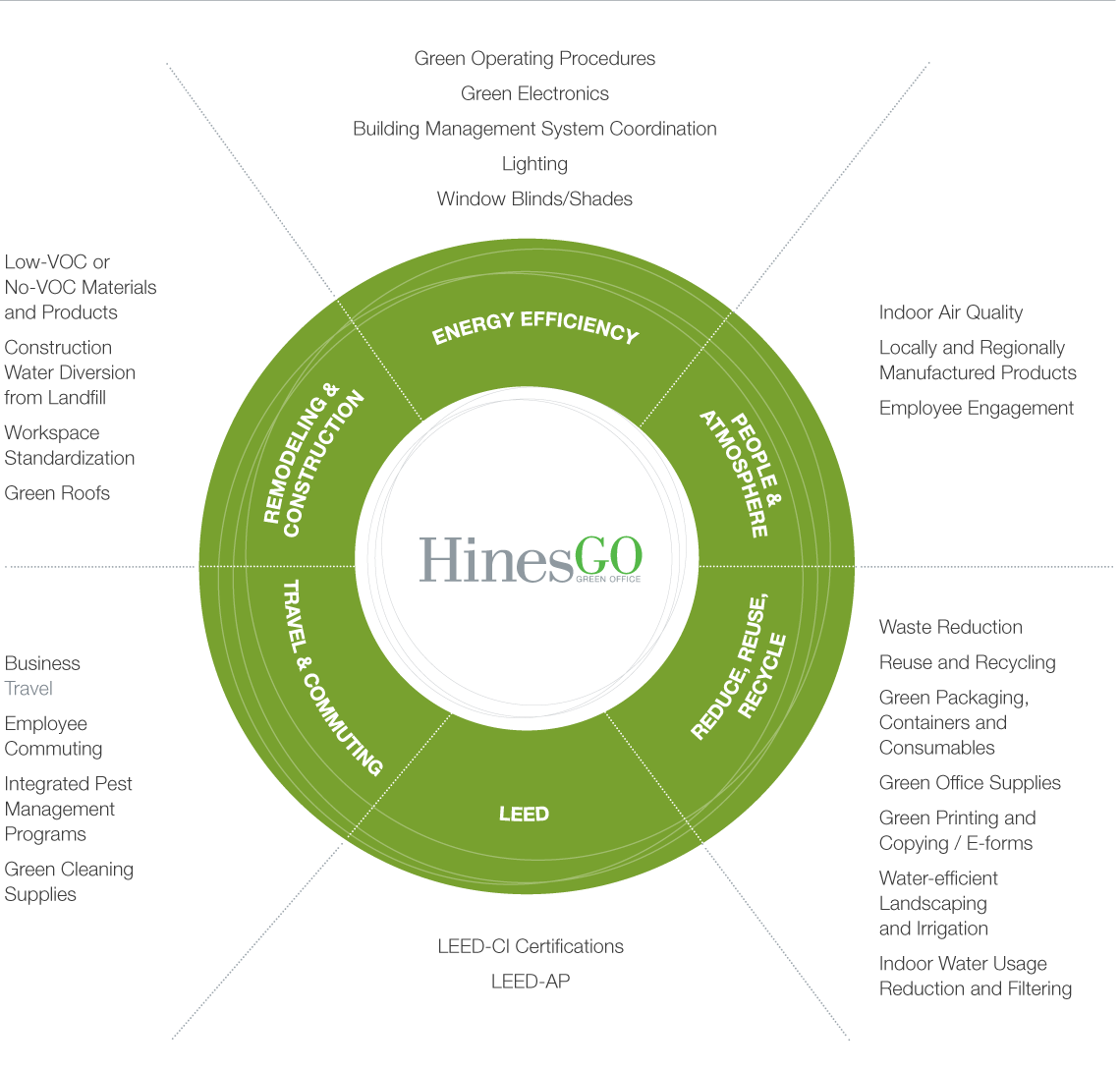
Hines administers a Best Practices Program to promote innovation by operations, engineering, design and construction professionals. A best practice is defined as a documented tactic, strategy, process, new technique or new technology that produces superior performance and is readily adaptable to other Hines offices or properties.
Ideas are submitted to a committee, evaluated and approved if they meet standards for efficiency, value, applicability, creativity and quality. Awardees are acknowledged with various forms of recognition.
The global program currently represents more than 300 best practices submitted by over 83 teams and 225 individuals; seven best practices were approved in 2017, five in the Engineering department and two in the Operations group.
Hines has partnered with Staples to supply eco-conscious products including paper, ink toner and printers as well as janitorial supplies and furniture. Many of these products meet environmental standards like EPA Safe Choice certified cleaners, Fair Trade certified coffees and ENERGY STAR certified electronics.
Security and cleaning services are provided by third-party contractors in Hines-operated properties. Hines expects all of its service contractors to comply with applicable laws relating to payment of wages and benefits, worker health and safety, interacting with labor organizations and other workplace laws. U.S. security, cleaning and other contracts include clauses for insurance, liability, non-discrimination, confidentiality and Office of Foreign Asset Control (OFAC). Respecting labor union relations, Hines is committed to a position of neutrality, guided by the interests of its partners, investors, clients and tenants.
Hines communicates property-specific procedures in tenant manuals, distributed in print and, increasingly, in digital formats. In addition to basic property management resources, security and emergency response instructions are included for medical, fire, earthquake, terrorism and other emergencies where applicable. Tenants are also oriented to heating, cooling and ventilation systems, and other automated systems, to ensure a balance of comfort and efficiency.








